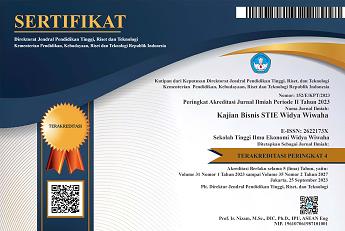EVALUASI PENGEMBANGAN SUMBER DAYA MANUSIA: SEBUAH REVIEW
DOI:
https://doi.org/10.32477/jkb.v23i1.171Keywords:
human resources development, return on investmentAbstract
Human resource management (HRM) is a recognition of the importance of human labor as vital resources that contribute to the goals of the organization, and utilization of multiple functions and activities to ensure that they are used effectively and fairly for the benefit of individuals, organizations, and society. Now human resource management has a unique and timely opportunity to improve productivity. Eventhough, productivity improvement does not means only increase the output. In addition, the evaluation of program responsibles and meets the special needs of employees with efficient cost. It is a very effective manner that very important, as organizations are tempted to cut costs and improve quality in their company. Without evaluation, it is very difficult to demonstrate that the development is the reason for the improvement. Human Resources Development can maintain and support productivity, as well as company isolate of lack of expertise of the human resources for the current job and future. The results are used in evaluating development programs include participant satisfaction with the training and development program development, learning knowledge or skills, the use of knowledge and skills on the job, and the results such as sale, productivity, or the prevention of accidents. Evaluation can also compare costs against benefits that receive development (return on investment).
References
Burrow, J. & Berardinelli (2003), “Systematic performance improvement-refining the space between learning and results”, Journal of Workplace Learning,Vol.15 (1),
Chmielewski, T.L. & Phillips,J.J (2002), “Measuring Return-on-Investment in povernment: Issues and Procedures”, Personnel Management, Vol. 31 (2),
DeSimone,Werner,Harris (2003), Mason Human resource development: South Western
Grove, D.A. & Ostroff, C.(1991) Developing Human Resources:Program Evaluation, Washington: DC: Bureau of National Affair
Grugulis, I (2007), Skills, Training and human resource development. A Critical Text. Palgrave Macmillan,
Han, H. & Boulay,D.(2013), “Reflections and Future Prospect for Evaluation Human Resource Development,Organizat ional Behaviour and Human Resource Management, http://adh.sagepub.com/content/7/1/ 5.abstract
Kirkpatrick, D. L.(1998), Evaluating Training Programs: The Four Levels. San Francisco: Berrett-Koehler Publisher, Inc.
Kirkpatrick, D. L.( 2009), Kirkpatrick’s Training Evaluation Model. http://www.findarticles. com/p/articles.
Kirkpatrick’s Evaluation Model as A Mean of Evaluation Teacher Performance. http:// www.findarticles.com/p/articles.
McDavid & Hawthorm. (2006). Program Evaluation & Performance Measurement An Introduction to Practice. SAGE Publications.
Noe, R.A.(2005) Employee training and development (third ed.). New York: McGraw-Hill.
Partners.,C (2006). Implementing the Kirkpatrick Evaluat ion Model Plus. ht tp: / / www.coe.wayne.edu/eval/pdf
Phillips, J.J(1983), Handbook of training evaluation and measurement Methods, Houston: Gulf Publishing
Phillips, J.J.(1996) How much is the Training? Training and Development, April, p. 20-24.
Rogers, E.W. and Wright, P.M. (1998) Measuring organizational performance in strategic human resource management: Problems, prospects, and performance information markets ,Human resource Management Review, Vol. 8 (3),
Yusuf,A.E & Suwarno (2011), Pengembangan SDM, Edisi 1, Jakarta: Penerbit Universitas Terbuka









